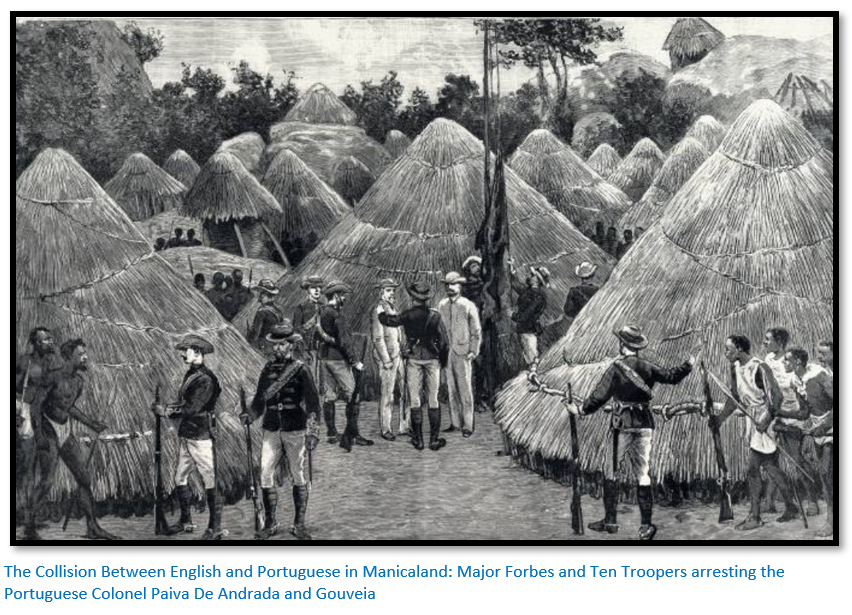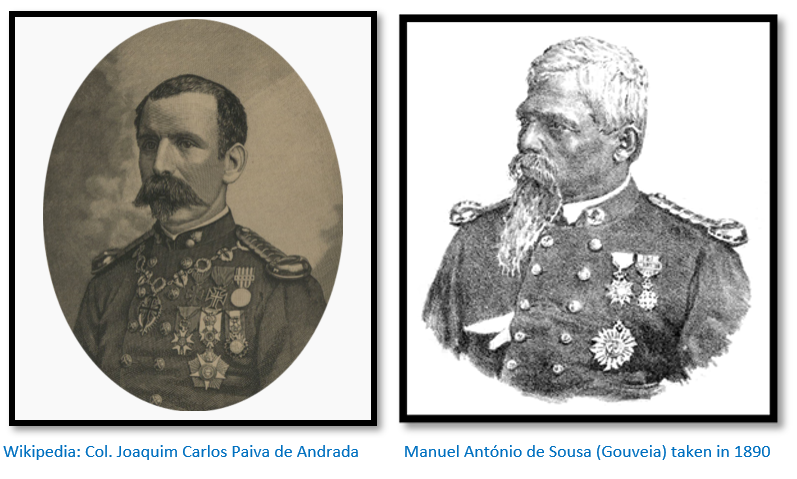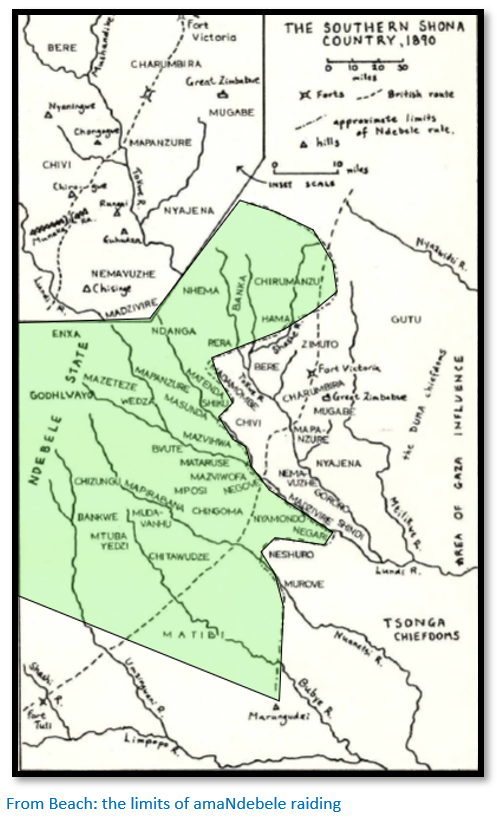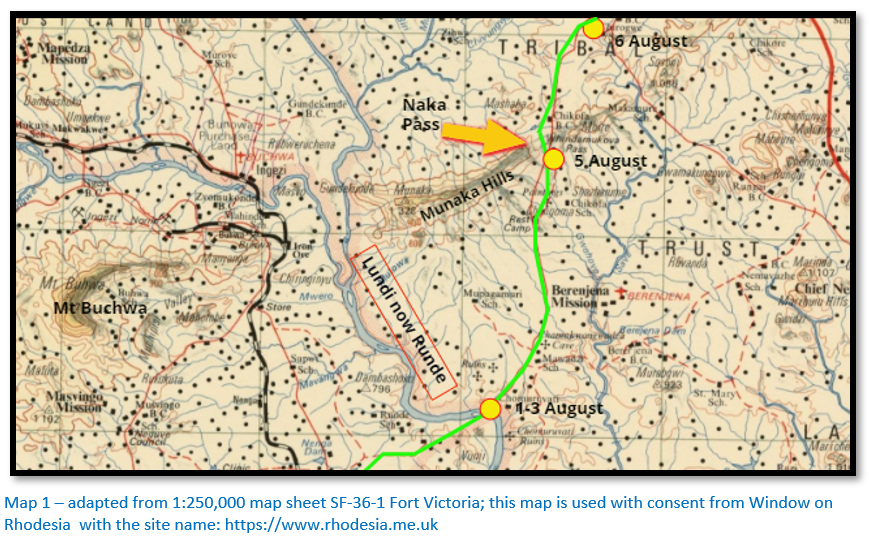The Adendorff trek and the planned invasion of Banyailand
Background
The Adendorff or Banyailand trek was made up of Afrikaners who wanted to establish a Boer Republic across the Limpopo river in 1890 – 91 in what was to become Southern Rhodesia, now Zimbabwe. The publicity in the Transvaal Observer resulted in Rhodes, Sir Henry Loch, the High Commissioner at the Cape and Paul Kruger, President of the South African Republic meeting on 21 March 1890 at Blignault’s Point on the Vaal river. Kruger agreed to act and threatened to confiscate the trekkers land which scared them enough to stop any trek taking place in 1890.
On 24 June 1891, a group of armed Afrikaners under Col. Ignatius Ferreira assembled on the southern bank of the Limpopo and threatened to move into Mashonaland and proclaim a Republic by armed invasion. The leaders were arrested by British South Africa Company Police and Dr Jameson persuaded the remainder to disperse stating they were welcome to settle providing they obeyed the laws. Some members of the trek later settled peacefully in Mashonaland.
This threat building up from south was accompanied by a Portuguese threats to Manicaland as explained below.
A build-up of threats to the newly occupied territory of Mashonaland
On 15 November 1890 Col. J.C. Paiva De Andrada and Gouveia had strong-armed Chief Mutasa into reneging on his concession with the BSACo. Whilst the two were meeting with the Chief, Capt. P.W. Forbes accompanied by ten men entered his kraal on Bingaguru and arrested De Andrada and Gouveia whilst Sub-Lieut E.W. Fiennes dispersed their followers, the only casualty being Trooper F.D.A. Payne of B Troop who whilst hauling down the Portuguese flag, snapped the top of the pole, which fell on his head and knocked him out.
The story of how Forbes followed up this success and then advanced to within two days march of the sea before being recalled to Macequece on the orders of the acting Administrator of Mashonaland, A.R. Colquhoun who was anxious that the event would cause a diplomatic incident between Portugal and Great Britain, is explored in detail in the article How Mutare and Manicaland were annexed from the Portuguese under Manicaland on the website www.zimfieldguide.com
In Portugal there was a great wave of popular indignation to the above events. Col. Joaquim Machado, Governor of Manica and Sofala proclaimed martial law in 1891 throughout the province. A body of students and volunteers left Portugal for Mozambique landing at Beira at the end of February 1891 and moved slowly towards Macequece suffering many casualties along the route due to lack of supplies and fever.
Early in May 1891 Lieut-Col Pennefather, commanding officer of the British South Africa Company (BSACo) Police went to Manicaland to assess how much of a threat the Portuguese military advance towards Macequece, on the border with Manicaland, represented to the BSACo. A party of eighteen Police and 1,000 natives under Lieutenant F.W. Bruce was cutting a road from Penhalonga to the nearest navigable stretch of the Buzi river and had reached Umlewan’s kraal. They were ordered to withdraw and reinforce Capt H.M Heyman’s Police force at Penhalonga.
The firm of Johnson, Heany and Borrow had contracted to launch a transport service from the Manicaland border to Fontesvilla on the Pungwe river and had a large supply of stores and construction material waiting at the Pungwe mouth at Beira on the Norseman. Capt. John Willoughby was refused permission to take the stores up the Pungwe river and when he attempted to take them in the tugboats Agnes and Shark towing lighters, the boats were halted by Portuguese gunboats.[i]
Leonard saw the two as they were being escorted as prisoners through Fort Tuli. Sub-Lieutenant Mundell of C troop who was escorting them described de Andrada as a gentleman and very nice fellow. Leonard writes that: “He is very swarthy and slight and in appearance not unlike a dark-skinned dancing-master. He is naturally very indignant with the fact of his having been made a prisoner in what he considers is Portuguese territory by mere filibusters acting on the orders of an able adventurer without receiving the countenance of the British Government.”
De Sousa (Gouveia) is described by Leonard as: “a notorious slave-dealer and villain and virtually ruler of the whole of Manica, but you would not think so by his looks, which evidently belie him and his placidity was in marked contrast to de Andrada’s irritability…was dressed in a striped sleeping-suit of various colours and appeared to be rather a retiring, mild-mannered, old half-caste gentleman.”[ii]
A new threat arises from the south where a band of Transvaal Boers under Col. Ferreira were planning an incursion over the Limpopo river to occupy Banyailand in the south-east of Mashonaland.
In February 1890 Selous had warned Rhodes that du Preez had told him in the Soutpansberg: “that for some years past the Boers in the Soutpansberg district have been preparing for a Banyailand trek.”
Having reduced the numbers of BSACo Police at the end of 1890 to save the Chartered Company further cash outgoings, new troopers had to be recruited in the early months of 1891 to face the new threat from the south.[iii]
The Boers of the Soutpansberg had hunted for a long time in the territory north of the Limpopo river, see the article Karl Mauch, explorer and geologist and the man who claimed to be the first European to visit Great Zimbabwe under Masvingo on the website www.zimfieldguide.com and they had been frustrated by Rhodes and the Chartered Company. They challenged the whole basis under which the Royal Charter had been granted to the Chartered Company – that Chiefs’ Chivi and Matibi owed allegiance to Chief Lobengula and that Lobengula was the overall ruler of Mashonaland to the Portuguese border.[iv]
The Mercury of 1 May 1891 carried a story stating: “…They report the number of those who will meet on the banks of the Limpopo to take part in the trek on the 20 June as rapidly increasing to one thousand. Everyone taking part provides himself with every requisite. Preparations are already a foot. New wagons are being bought and a stock of ammunition laid in. The trekkers say that the Chartered Company has no right to Mashonaland and their own claims are founded first on a treaty in the 1830’s between the first Commandant Hendrik Potgieter and the Chief Chibi of Banyailand; second, on a verbal ratification by the Chiefs Shebasha and Koodo, and thirdly on written treaties with the two former dated 5 August 1890 published in European papers by General Joubert during his visit to Europe...”[v]
Beach writes that in 1890 JLH du Preez and BJ Vorster stated that from 1874 the Shona Chiefs Chivi and Matibi had requested the Afrikaners’ to: “come and live with them to protect them from the murder raids committed on them by the nation of Moselekatze [Mzilikazi]”[vi] That in 1880 a Shona deputation arrived in the Soutpansberg to repeat the request and that in 1884 the Afrikaners’: “had a mutual understanding and had procured cession of certain parts of Baijaailand from the Baijaai.” However, du Preez and Vorster were promoters of the Adendorff concession which they had secured in August 1890 and anything they said should be treated with caution.
The Banyailand concession
Louis Adendorff and Klein Barend Vorster claimed to have a Banyailand concession from the two chiefs covering an area of 200 miles by 100 miles[vii] and when Rhodes refused to purchase the concession, ambitious plans took place to gain by force what had been lost through diplomacy although it may have all been a scheme to blackmail the BSACo. The plans were for 1,500 – 2,000 Boers to cross the Limpopo river at Middle drift during the 1890 dry season and the stated reason was that Chiefs Chivi and Matibi of Banyailand needed protection against amaNdebele raiding parties.[viii]
However, President Kruger persuaded the Boers to delay their crossing and by 13 September 1890 the Pioneer Column had reached Fort Salisbury and the occupation of Mashonaland by the BSACo was now a fait accompli.
In 1891 the Boers led by Col. Ignatius Ferreira and privately encouraged by General Piet Joubert; Commandant-General of the Transvaal decided to push on ahead with their plans. These plans became known to the Foreign Office; Gen Sir Frederick Carrington was placed in command of the area from Mafeking down the Limpopo river to the Indian Ocean with Capt John Willoughby placed in command of the Limpopo drifts. The Bechuanaland Border Police (BBP) were used for guarding the drifts from the Transvaal to Khama’s country, present-day Botswana.
Dr L.S. Jameson, although he did not succeed A.S. Colquhoun as Administrator of Mashonaland until September 1894, was sent with Willoughby to Pretoria in an attempt to dissuade Col. Ferreira and his followers from attempting such a foolhardy mission. At the same time whispers of these plans brought Lieut-Col Pennefather from Manicaland down to Fort Tuli in early May 1891.
Leonard writes on 2 June 1891: “Grey came in from Masebi’s [Massibi’s] drift yesterday and says there are a large number of Boers at the second and third outspans from the main drift on the Crocodile [Limpopo], but he has no idea of their numbers…So there is something in the trek after all, but that is the most one can say for it – a mere trek of a few discontented men, who have been put up to coming by Messrs Adendorff and Barend Vorster, a pair of wily agitators who want to annoy and disconcert Rhodes.”[ix]
The fallacy of the Rudd Concession
The Rudd Concession with Lobengula resulted in the Royal Charter being granted to the Chartered Company. It also was the only agreement upon which the Chartered Company based its right to build the Pioneer Road and to occupy Mashonaland in 1890. It assumed that the amaNdebele ruled as far as the Sabi river in the east and from the Limpopo river into northern Mashonaland. Although Selous stated the Pioneer Column Road skirted the amaNdebele Kingdom, it was generally assumed by all that they were in amaNdebele controlled territory and they took constant precautions against attack by putting out flanking parties and laagering the wagons at night.
Beach writes that Pennefather attempted to sign a treaty with Chief Chivi, but Colquhoun wrote to Rutherfoord Harris: “Both Jameson and I thought it wise not to take the step, but to assume Lobengula’s authority.” Rutherfoord Harris agreed and Pennefather was told to keep this matter out of his Progress Reports and write confidentially to Rhodes, which he did.[x]
Jameson commented: “The Colonel seems to have a weakness for the flag and treaty trick…within the limits which Loben [Lobengula} claims, using Limpopo on the south and Sabi on the east. This would surely be rather dangerous, as it would give a handle to opponents saying that making a treaty with one, we ought to make it with all. Thus, the Colonel saw the farce as regards Matipi [Matibi] and Setoutsi [Setoutse] who themselves acknowledge they are contributary to Loben [Lobengula]; but Tschibi [Chibi] it seems denies having anything to do with the amaNdebele, having beaten them off when attacked.”[xi]
Rutherfoord Harris most emphatically agreed: “Don’t let Pennefather repeat that treaty business, although done with the best motives still you and Jameson are right, and it is most impolitic: we stand on one pillar only west of 33°East” and:” …It is impossible to commence an independent Mashonaland with an infinite number of ragged miserable Chiefs.”
The situation on the Limpopo river – Captain Leonard acts
Despite these efforts numbers of Boers began to assemble on the southern bank of the Limpopo river. At Fort Tuli Capt A.G. Leonard commanding E Troop of the BSACo Police was given orders to watch the major drifts across the Limpopo river. In April he took the following actions:
- Capt W.A. Barnett was sent to cut a road to Main drift in the vicinity of present-day Beit Bridge.
- Lieut. W. Hicks-Beech was sent with twenty Police to build defensive positions at Rhodes Drift and to stop anyone crossing if they posed a threat.
- In early May, after Capt Barnett had returned after completing the road, he was sent to Massibi’s drift with thirty Police to build defensive positions.
- Then a telegram from Gen Carrington requested that fifty Police and a Maxim gun be sent to Sterkstroom drift.
Asked by Carrington how many Police he had left to form a mobile column, Leonard replied he did not have enough men to go to Sterkstroom, let alone to form a mobile force. In response, the BBP were ordered to Rhodes drift and Hicks-Beech returned to Fort Tuli.[xii]
Other preparations to counter the Boer threat
At the Naka Pass, north of the Lundi river, D Troop under Capt E.C. Chamley-Turner and F Troop (Artillery) under Capt C.F. Lendy were ordered to build Maxim gun defences dominating the Pioneer Column road through the Naka Pass (called Mhindamikova Pass on the 1:250,000 map) in the Munaka Range.
More effort and resources were put into the erection of the telegraph line; it reached Macloutsie on 12 May 1891 and Fort Tuli on 28 May…this greatly speeded up despatches which previously had gone by heliograph, or by dispatch-rider. The proposed extension to Fort Victoria was also surveyed. Leonard writes: The telegraph people are pushing ahead with the line to Nuanetsi and Goody and I have been for a ride up the Shashe to see the span across the river, which Moir tells me is 518 yards from pole to pole, the weight of the wire being about 130 lbs. The ground on the western bank is not so high as it might be, but on the east bank, luckily it is high, for it helps to keep up the span which droops considerably towards the opposite centre.”[xiii]
Towards the end of May Capt Willoughby arrived at Fort Tuli to supervise the strengthening of the Forts’ defences but was only there a week before he was superceded by Col. H. Goold-Adams of the BBP. Apparently, Willoughby had spoken too frankly to President Kruger on his and Dr Jameson’s earlier visit to Pretoria.[xiv] Leonard writes: “Goold Adams however, seems a nice, sensible sort of fellow and he tells me that Willoughby is to go up to Manica, to be put out of the way.”[xv]
Leonard calls Willoughby “That fidget on wheels, although he has been here only six days, has done simply wonders, first of all in trying to make our fort impregnable, having quite lost sight of the main fact, that its position against artillery and even accurate rifle fire such as the Boers could bring against it, is absolutely untenable. And now he is down at the drifts drawing up plans and devising deadly means to meet the Boers with…The most amusing part of his expansive scheme has been to send one of my men, disguised as a civilian, across the Crocodile [Limpopo] as a spy, with most elaborate instructions to send him daily budgets, but how he does not say – to be left to chance, as usual, I ween.”[xvi]
The map below shows the progress of the Pioneer Column across the Lundi, now Runde river with the dates and places in 1890 they laagered and the Naka Pass which was defended by the BSACo Police in May-June 1891.
Capt A.G. Leonard’s view of the defences
Leonard was not optimistic about the chances of defending the drifts, but on the other hand did not think the Boers were that determined either. There were seventy Police with two Maxim guns guarding some, but not all the drifts over the Limpopo river. Leonard felt his one hundred and forty men and two Maxim guns should have been concentrated in one spot with patrols watching and patrolling the drifts ready to react, rather than scattered in small groups along the Limpopo river and “even out of the sixteen horses we have, half of them are broken-down old crocks that would not stand one day’s hard work.”
- Nevertheless, on 3 June 1891 Lieut. S. Flower with sixty-five Police and five wagons were sent to defend Massibi’s, Main and Middle drifts
Events of 24 June 1891 at Main drift
Dr Jameson arrived at Fort Tuli on 3 June followed by Lt-Col Pennefather on the 19 June. Jameson left Fort Tuli in a Cape cart on 20 June to make a tour of the Limpopo drifts and left four days later from Main drift for Matibi’s kraal. On that day the officer commanding at Main drift, Lieut R.H. Ord-Capper was ill with fever, Goold Adams was away at the lower drift and the only police officer present was Surgeon-Lieut E. Goody.
A party of one hundred and twelve Boers with wagons, mostly from the Waterberg district of the Soutpansberg and about one hundred native servants were camped in the southern bank of the Limpopo river with their leader Col. Ignatius Ferreira.
The main body remained on the southern bank whilst a group of five armed men, including Col. Fereira and his secretary Jerome rode across the river and were allowed to pass the defensive line and ride into the main BSACo Police camp.
There are two versions of what followed:
(1)Leonard states that Goody, acting on his own initiative, arrested Ferreira and his men and sent for Dr Jameson and Col. Goold-Adams.
(2)Trooper H.W. Chawner No 615 in charge of the commissariat and with much previous service was approached by the Sergeant in charge and asked what to do. He said: “Disarm them and make them prisoners and send for the Doctor.”
Leonard writes: “Jameson came in from the drifts today (28 June) at 3:30pm and says that the Boer trek is virtually over…” He then comments that none of the Police officers were present. “Goody, however, was quite equal to the emergency and sent mounted men off for himself [Jameson] and Goold Adams. He [Jameson] was overtaken before he had even driven more than eight miles and when he returned, he found that Ferreira, the leader of the trek, had on crossing over to our side of the river, been made prisoner by the wily Goody.[xvii]”
Whatever the truth, Leonard comments that: “…the doctor [Goody] had his head screwed on the right way and did the right thing.” Ferreira submitted quietly, but one of his companions, a bearded Boer with a red tie, was very angry and noisy, but eventually calmed down.
Leonard continues: “Jameson then taking an interpreter and Ferreira with him, went over to the Boer outspan. On arrival there, he informed them that they would not be allowed to cross the river and advised them to appoint a deputation, to whom he would be only too happy to grant an interview and having again warned them not to make any hostile attempt to invade our territory, he returned to the camp.”
“The next morning the Boers sent Messrs Senekal, David Malan and Pete Marais to represent them, who intimated to Jameson that it was their intention to occupy Banyailand by virtue of a concession which they had in their possession and on the strength of which they refused point-blank to sign any document or comply with any rules or regulations of the Chartered Company.”
In spite of the protests of Adendorff and Barend Vorster who held the Banyailand concession, the talks went peacefully. Jameson said those who wished to settle in the Chartered Company’s territory and were willing to obey the laws would be welcome. The trekkers then dispersed, although some with an eye to business began selling meal, tobacco and salted horses to the troopers. Others applied for permission to hunt and said they would sign any documents required by the Company, others asked if they could join the BSACo Police!
Ferreira and Jerome were brought on parole to Fort Tuli on the 29 June and then permitted to remain in Mashonaland. They set up a company…the Mashonaland Agricultural and Supply Syndicate with Ferreira as managing director and Jerome as secretary and even persuaded some of the officials at Fort Tuli (White, Browne, Nesbitt, Tye and Leonard) to subscribe for shares in the company.
Leonard says even before this incident: “I have said all along that not a shot will be fired if the Boers are handled with tact and discrimination and I think, if my first impressions are correct, Goold Adams is the right man in the right place, either for diplomacy, or if necessary, for a row.”[xviii]
The BSACo Police force is run down once again
With both the problems of the Portuguese in Manicaland and those of Ferreira’s freebooters in the south solved, the Chartered Company looked once again at reducing cashflow and reduced all recruitment in July 1891. In September and October very many of the Police took their discharge, some remaining to go mining or farming, but many left the country with the Chartered Company paying their transport as far as Fort Tuli where they took their discharges.
References
D.N. Beach. The Adendorff trek in Shona History.
J.S. Galbraith. Crown and Charter: The Early Years of the British South Africa Company. University of California, 1974
A.S. Hickman. Men who made Rhodesia. The British South Africa Company, Salisbury, 1960
C.H. Mazarire. Memories and Contestations of the Scramble for Zimbabwe: Chivi (Mashonaland) c. 1870 – 1892
Notes
[i] Men who made Rhodesia, P31
[ii] How we made Rhodesia, P151
[iii] Ibid, P33
[iv] Beach states that European opinion that both Chiefs Matibi and Chivi were helpless victims of the amaNdebele is far from correct. There was widespread availability of muskets from the 1860’s from the Portuguese, British traders who sold them illegally and Venda gun sellers in the Transvaal. The Shona quickly learned to repair muskets, make gunpowder and cast ammunition and learnt to fight from their kopje strongholds and from the cover of their dry-stone walls.
[vi] The Adendorff trek in Shona History
[vii] Crown and Charter, P270
[viii] Beach writes that there were two groupings of Shona Chiefdoms with regard to the amaNdebele. Those who had a political relationship and paid tribute and those who did not. In the latter category, some Chiefs were beyond the reach of the amaNdebele raiders, some resisted the amaNdebele and some occasionally paid tribute to escape raids but did not pay tribute regularly.
[ix] How we made Rhodesia, P235
[x] The Adendorff trek in Shona History
[xi] Ibid
[xii] Men who made Rhodesia, P34
[xiii] How we made Rhodesia, P253
[xiv] https://paperspast.natlib.govt.nz/newspapers/MIC18990818.2.46. According to the Mount Ida Chronicle of 18 August 1899 Willoughby had a talk with Oom Paul in which he tried to frighten the old man. At last, Oom Paul said with an impatient shrug of his shoulders:” I can do no more to stop the trek; what must be, must be.” Tell him said Sir John to the interpreter: “That I say it will mean war – war.” Oom Paul waited to hear the remark slowly translated and then he said: “And I say that I have had experience of war already.” “Then tell him” said Sir John: “that he won’t have to deal with the Chartered Company – he’ll have to deal with the British Army.” “And I say” broke in the old man: “that I have dealt with the British Army once already.”
[xv] How we made Rhodesia, P236
[xvi] Ibid, P236
[xvii] Ibid, P253
[xviii] Ibid, P237








